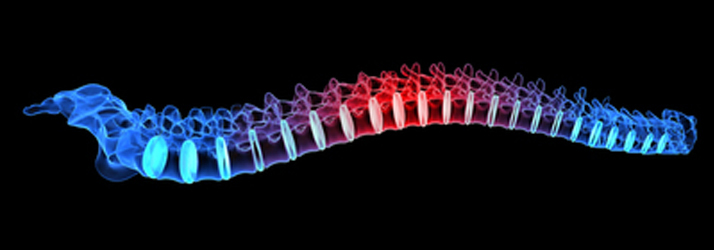Computerized Radiographic Mensuration Analysis and Ligament Laxity in Tampa

We commend you for taking responsibility for your own health and recovery from injury. By reading this page from your local Tampa chiropractor, you will learn vital information about how you may be able to help your doctor to help you even more. That’s because many doctors are not yet familiar with Computer-aided Radiographic Mensuration Analysis (CRMA) and its usefulness in treating the injured patient.
What Are Hidden Injuries in Tampa?
Hidden injuries are injuries that are not immediately discovered by the diagnostic tests commonly ordered by most doctors. That includes medical physicians and doctors of chiropractic. If you’ve been involved in an automobile collision or some other type of traumatic event and have significant symptoms and/or restricted function, then you’ve probably already had X-rays, CAT scans and MRI's. However, if you are still experiencing symptoms and are concerned that you may never fully recover—or worse, you’re experiencing very little progress even with treatment—then you, like thousands of other accident victims, probably have hidden injuries.
Hidden injuries are usually in the soft tissues of the spine. Unfortunately, insurance companies and their doctors often say things like “It’s just a soft tissue injury so we’re not paying for any more treatment and we’re not willing to give you more than $X to compensate you for these minor injuries.” Your first response to that reply may be just like most people who say, "It doesn't feel minor to me!"
According to the Spinal Research Institute of San Diego, approximately 6 million car accidents occur in the USA each year. Of those 50% or 3 million are injured and 300,000 become permanently disabled from those injuries. Thousands of people are also injured at work every month. Many of these injured people find that “all the tests came back negative." As a result, their treatment may get cut off because their doctor cannot justify it to third parties such as insurance carriers. If this applies to you or someone you care about, then please keep reading to find out how CRMA is able to help many of these suffering individuals.
Our CRMA looks at some of the more critical “facts” or “objective findings” that will help your doctor to better understand your injuries. These "facts" are called "objective findings" because we report on what physically exists in the x-ray images. Sometimes the CRMA report will contain no major findings. However, that can still be very helpful by helping your doctor to look elsewhere for the cause of your symptoms. At other times the CRMA report will find the specific location and severity of injury even after all the other tests did not find any evidence of injury.
Benefits of CRMA to you
Find the cause of your pain—If your doctor performs a CRMA, the X-rays will be analyzed carefully. A biomechanical and mensuration report will then be produced. This diagnostic procedure is capable of finding the exact location of a hidden injury usually consisting of injured ligaments. If present this provides critical information that helps your doctor to find the cause of your pain.
- Avoid further injury—Knowing precisely which spinal level or levels have ligament injury and therefore weakness helps you and your doctor to avoid doing anything that could cause further injury.
- Faster and more complete recovery—Diagnostic testing can give both you and your doctor a better understanding of the precise location and extent of your spinal injuries. This can help your doctor to modify your treatment in order for you to have a faster and more complete recovery.
- Document your injuries to help assess permanent impairment—We can objectively document the presence or absence of commonly missed spinal injuries caused by trauma. This analysis can also accurately measure the extent of spinal injury. If the ligaments are injured, this usually causes laxity allowing increased movement between the vertebra. This is also called “slippage.” The amount of slippage is measured and compared to the AMA impairment guidelines. If present, a permanent impairment rating provides insurance companies and other third parties important information about the permanency and objective significance of your injuries and the ongoing need for treatment and/or pain management in the future.
Orthopedic Surgeon Explains Benefits of CRMA
Jere Sutton D. O. FAASOS
“When taking care of the injured patient, the need for objective documentation is extremely important to prove that an injury exists and to give credence to a disability rating. Appropriate x-ray studies with CRMA [Computer-aided Radiographic Mensuration Analysis] validation, tells the truth with irrefutable verification. I have been in practice 48 years and CRMA along with appropriate x-ray studies is the best validation that I have experienced."
“CRMA is a powerful diagnostic test for ascertaining the location and extent of injury and aids in treatment decisions.”
It is well understood that:
“Find the cause so that you may discover the solution.”
Most people don’t realize that so many symptoms can be caused by ligament injury.
Headaches, neck and shoulder pain, arm pain, numbness and even weakness can be caused by ligament damage in your neck. Low back, buttock, hip, leg and foot symptoms can be caused by ligament injury in your low back. Unfortunately, most static MRIs do not fully identify spinal ligament injury (see discussion below for more details). Neither do regular x-rays or CAT scans. Therefore these injuries remain “hidden” which means the cause of symptoms stays undiscovered.
How Do We Know These Symptoms Can Be Caused By Ligament Injury?
There are many scientific studies and textbooks that explain how these symptoms can be related to ligament injury. One very good discussion on this topic is provided by the Yale University scientist, Dr. Panjabi, in his paper titled “A Hypothesis of Chronic Back Pain: Ligament Subfailure Injuries Lead to Muscle Control Dysfunction.”
How Can Ligament Injury Be Diagnosed?
CRMA of your spine is often the most accurate way for your doctor to determine if you have ligament damage. It can accurately pinpoint the location and extent of ligament injury. This will enable your doctor to give a more complete and accurate diagnosis of your injuries. It may also provide more effective treatment options.
CRMA has been found to be accurate. A recent study concluded that “As with other studies investigating the reliability of Radiographic Mensuration Analyses, this study reports a high degree of intraexaminer and interexaminer reliability of the procedure.”2
Unfortunately, few doctors are aware of this remarkable technology. Even though CRMA was created over 30 years ago by Dr. Suh at the University of Colorado3, recent advances in computer science and scanners have enabled the latest procedures to be far more accurate.
The Importance of Diagnosing Spinal Ligament Integrity
Integrity means “completeness, unimpaired condition, soundness (Webster's New Compact Office Dictionary 2003). The normal cervical or lumbar spine has a smooth lordotic curve). A straightened or reversed cervical curve indicates ligament injury.
The anterior longitudinal ligament (ALL) and posterior longitudinal ligament (PLL) are common sites of injury during whiplash. It is generally understood that when the ALL or PLL is injured, it results in either forward or backward slippage primarily due to ALL injury. In more serious cases, the Ligamentum flavum will be injured. CRMA is usually the most appropriate diagnostic test for an initial investigation in order to determine if these injuries are present.
The human spine is made up of 24 vertebra. It is the “backbone” of your mobility and health. Vertebra have 3 important functions.
They:
1. Protect the spinal cord and nerves.
2. Support the weight of your body.
3. Allow your body and head to move.
Ligaments hold the vertebra together and make the above functions possible. Ligaments act like a door hinge. If the hinge is damaged, the door will not function properly.
CRMA is able to accurately measure the total slippage by adding forward slippage to backward slippage. Many radiologists still attempt to eyeball this slippage and give an “educated guess” about whether they consider it an injury or not. However, in our experience it is very difficult and often impossible for the human eye to accurately add both the forward slippage and backward slippage, especially given that these are found on 2 different x-ray films so cannot be seen at the same time. We commonly see that the radiologists make comments like “Normal motion observed” when in fact CRMA then reveals the presence of significant slippage. This misreading of flexion/extension x-rays is another reason why these injuries are so often missed and therefore remain as “hidden spinal injuries.”
The problem of missed injuries is especially easy to agree with when we explain that a slippage of just 1 mm can represent an injury. Imagine how unlikely it would be for even an experienced radiologist to "eyeball" an 0.8 mm forward slippage and add that to a 0.7 mm posterior slippage and come up with 1.5 mm total slippage. That would then need to be repeated at every vertebral level. CRMA can accurately make these calculations and then your doctor may reasonably be able to conclude the level with 1.5 mm to be injured, especially if it had other associated findings such as muscle spasm, tenderness and pain. Injury would then be even more strongly indicated if the vertebrae above and below had significantly less slippage. It may surprise you to learn that most radiolgoists do not do anything more than "eyeball" these slippages. If they did take the time to do pencil markings and measure them (which most do not), they'd be closer to being able to make a a decision about the presence or absence of injury. However, even that is problematic as hand mensuration has been shown to have a 40% margin of error.
The “slippage” discussed above is referred to as “translation” in the CRMA report.
Another way that CRMA can find injuries is with its angular measurements. The process of calculating these abnormalities has been outlined in detail by the AMA Impairment Guidelines and is even more complex than calculating translation.
Upper Cervical Spine
Injury to this part of the spine is common after auto collisions, yet static MRIs have a poor ability to identify the majority of these injuries since they will not be seen unless the injury is extensive. Yet severe symptoms can result with ligament subfailure. CRMA is effective at identifying that subfailure.
The alar and accessory ligaments stop excess lateral movement of C1 on C2. These ligaments are also commonly injured by whiplash. CRMA can help your doctor determine if these ligaments are injured and if so, quantify the extent of this injury.
What Are Impairment Ratings and Why Are They Important to You?
Certain types of excessive vertebral movement will result in an impairment rating being given in the CRMA report. The importance of thse ratings was discussed above under the heading "Benefit of CRMA to you."
According to the fifth edition of the Guides to the Evaluation of Permanent Impairment, published by the American Medical Association (AMA Guides), impairment is defined as “an alteration of an individual’s health status; a deviation from normal in a body part or organ system and its functioning.” The World Health Organization (WHO) defines impairment as “any loss or abnormality of psychological, physiological or anatomical structure or function.”
The Social Security Administration (SSA) defines a medically determinable impairment as “an impairment that results from anatomical, physiological, or psychological abnormalities which can be shown by medically acceptable clinical and laboratory diagnostic techniques.”
What X-rays Are Needed?
There are 2 spinal regions that can be analyzed: the cervical spine (neck) and the lumbar spine (lower back).
If you are getting plain film x-rays, then flexion/extension films along with a neutral lateral view must be taken for a complete CRMA report to be generated.
If injury to the cervical spine is suspected, then either plain film flexion/extension x-rays or Digital Motion X-rays (DMX) can be used for the CRMA. In the lumbar spine only plain film x-rays are applicable.
How Do I Get a Report for Me?
Your doctor will need to have reason to suspect that you have spinal injury. He or she will then order plain film flexion/extension x-rays or Digital Motion X-rays (DMX) in the areas of suspected spinal injury.
After x-rays are taken, your doctor can review them for analysis. The report generated can then be used by your doctor to evaluate the effectiveness of your current treatment plan and make changes if necessary.
References
- Panjabi, M. “A Hypothesis of Chronic Back Pain: Ligament Subfailure Injuries Lead to Muscle Control Dysfunction.” Eur Spine J (2006) 15: 668-676.
- Troyanovich, SJ, et al. “Chiropractic Biophysics Digitized Radiographic Mensuration Analysis of the Anteroposterior Cervicothoracic View: A Reliability Study,” Journal of Manipulative and Physiological Therapeutics, Vol. 23, #7, September 2000).
- Suh, CH. “The Fundamentals of Computer Aided X-ray Analysis of the Spine.” J. Biomechanics, 1974, Vol. 7, pp. 161-169. Pergamon Press. Printed in Great Britain.
OFFICE HOURS
Monday
9:00am - 10:00pm
Tuesday
9:00am - 1:00pm
Wednesday
9:00am - 10:00pm
Thursday
1:00pm - 10:00pm
Friday
9:00am - 10:00pm
Saturday
By Appointment
Sunday
By Appointment
Precision Spine & Wellness Center
2529 West Busch Boulevard Suite 100
Tampa, FL 33618



